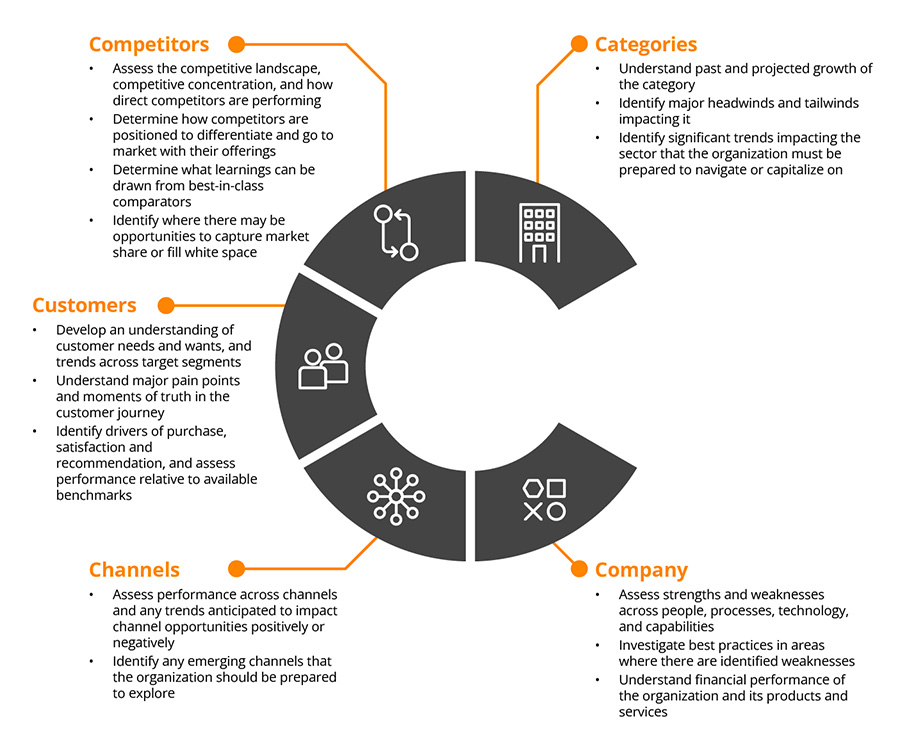
Article
Strategies that Stick: The Importance of a Strong Foundation
Laura Richard, Evin Demirli — March 20, 2025
Developing a strategy that sticks starts with building the right strategy and the commitment to deliver it. In our recent research, 75% of leaders felt that they could have collected more perspectives in strategy development, and that this was a barrier to their strategy’s success.
This points to the importance of a robust, data-driven approach to strategic planning. But what type of data should you consider? Who should be engaged to provide perspectives? And how can you ensure you don’t find yourself in a state of analysis paralysis?
The Foundation for Strategy Development: A Strong Fact Base
It can be challenging for leaders to find common ground and align to a sound strategy based on their individual experiences and opinions alone. Two issues arise out of this. First, leaders may have deep knowledge of their respective functions, but everyone only has a ‘piece of the puzzle’. Second, while leaders generally have a good read about their business and the environment it operates in, it is not uncommon for blind spots to exist, especially when their day-to-days are heavily focused on running the business.
Thus, a comprehensive fact base is incredibly valuable at the outset of a strategy development process; it helps reveal the full picture to leaders, reveals blind spots, and ultimately serves as the common source of truth upon which decisions are made.
When building fact bases, Level5 uses a ‘5Cs’ framework to build a holistic understanding of an organization and identify its major opportunities and challenges.
 Building a comprehensive view of your organization requires a mix of different research and data-gathering approaches. Doing so typically requires desktop research, primary customer research (whether qualitative, quantitative, or both), and reaching into the depths of the organization to gather key financial, operational, voice of customer, or employee related data.
Building a comprehensive view of your organization requires a mix of different research and data-gathering approaches. Doing so typically requires desktop research, primary customer research (whether qualitative, quantitative, or both), and reaching into the depths of the organization to gather key financial, operational, voice of customer, or employee related data.
Building Alignment: Stakeholder Perspectives
Engaging stakeholders across the organization is important both to the development of the fact base and to building aligned commitment to the strategy. It ensures that isolated pieces of information are brought together to form a cohesive picture from which decisions can be made. Moreover, when stakeholders feel meaningfully heard, they are more likely to buy-in and commit to the organization’s direction.
Guiding principles for collecting stakeholder perspectives are as follows:
- Leadership Interviews: Gather insights from senior leaders to understand their strategic vision, high-level challenges, and opportunities. This will determine the degree of ongoing leadership cohesion so that research and working sessions focus on resolving areas of misalignment.
- Engage “Next Level Down”: Involve middle management who will be largely responsible for implementing the strategy. They often have the best read on what is working (or not) in their respective functions. Moreover, providing these individuals with the opportunity to weigh in on the direction will help them feel valued and like a meaningful contributor to the process, increasing the likelihood of their buy-in and commitment to deliver it.
- Selectively Engage Front-Line Employees: Understand unique perspectives and practical challenges from those directly interacting with customers and operations. Engagement at this level can uncover leadership blind spots and provide an early indication of where implementation will be most challenging.
- Collaborative Leadership Workshops: Facilitate workshops to socialize and constructively challenge perspectives and hypotheses, ensuring alignment and buy-in at each step rather than developing the strategy with a few select individuals and delivering it in a grand reveal to the broader leadership team.
How Much is Too Much: Avoid Boiling the Ocean in Fact Base Development
When developing a fact base for strategic planning, an important pitfall to avoid is “boiling the ocean,” which refers to the inefficiency and complexity that can arise from collecting and analyzing excessive information.
To avoid the trap of “boiling the ocean”, it is imperative that teams outline major strategic questions at the outset, form hypotheses, and then focus research efforts on those. Engaging leaders before diving deep into research will help define those big questions and hypotheses. As a collective, leadership teams generally have a sound understanding of their business and what opportunities or challenges are present and will point you in the right direction to start.
Research should be viewed as an iterative process. As you uncover new information, you will validate hypotheses and know when to dive deeper, disprove some and know when to stop, and form new hypotheses to explore. They key is to be flexible and recognize when incremental investigation starts delivering diminishing returns – remember the 80/20 rule!
Conclusion
The fact that up to 82% of strategies don’t achieve their intended goals is partly caused by the shaky foundation on which they are built. For a strategy to stick, it must be the right strategy and have enduring commitment through the organization to deliver it. Building the right strategy requires that it is data-driven and informed by a breadth of internal and external perspectives. Internal perspectives should involve stakeholders throughout an organization, so that they can see it for themselves and buy-in to the direction the organization is heading. This increases the likelihood that the strategy will stick.




